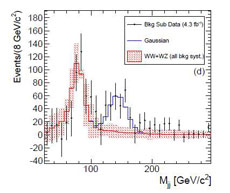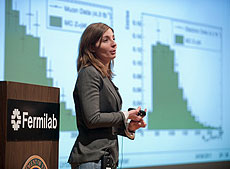The data peak that causes excitement

The di-jet invariant mass distribution for candidate events selected in an analysis of W+2 jet events. The black points represent the data. The red line plots the expected Standard Model background shape based on Monte Carlo modeling. The red shading shows the systematic and statistical uncertainty on this background shape. The blue histogram is the Gaussian fit to the unexpected peak centered at 144 GeV/c2

CDF Collaborator Viviana Cavaliere, University of Illinois at Urbana-Champaign, presents the new CDF result in Ramsey Auditorium on Wednesday, April 6. Cavaliere is one of the collaborators responsible for this analysis.

Pierluigi Catastini, Harvard University; and Alberto Annovi, INFN; are two of the other analyzers responsible for this analysis.
Wednesday afternoon, the CDF collaboration announced that it has evidence of a peak in a specific sample of its data. The peak is an excess of particle collision events that produce a W boson accompanied by two hadronic jets. This peak showed up in a mass region where we did not expect one. The peak was observed in the 140 GeV/c2 mass range, as shown in the plot above. It is the kind of peak in a plot that, if confirmed, scientists associate with the existence of a particle. The significance of this excess was determined to be 3.2 sigma, after accounting for the effect of systematic uncertainties. This means that there is less than a 1 in 1375 chance that the effect is mimicked by a statistical fluctuation. Particle physicists consider a result at 5.0 sigma to be a discovery.
The excess might be explained by the production of a new, unknown particle that is not predicted by the Standard Model, the current standard theory of the fundamental laws of physics. The features of this excess exclude the possibility that this peak might be due to a Standard Model Higgs boson or a supersymmetric particle. Instead, we might see a completely new type of force or interaction. A few models proposed and developed in recent years postulate the existence of new fundamental interactions beyond those known today, which would create an excess similar to the one seen in the CDF data. That's why everybody at CDF is excited about this result.
The alternative explanation for this excess would be that we need to reconsider the theory that is used to predict the background spectrum, which is based on standard particle physics processes. That possibility, albeit less glamorous, would still have important implications. Those calculations use theoretical tools that are generally regarded as reliable and well understood, and form the basis of many other predictions in particle physics. Questioning these tools would require us to challenge our understanding of the fundamental forces of nature, the foundation of particle physics.
The current analysis is based on 4.3 inverse femtobarns of data. The CDF collaboration will repeat the analysis with at least twice as much data to see whether the bump gets more or less pronounced. Other experiments, including DZero and the LHC experiments, will look for a particle of about 140 GeV/c2 in their data as well. Their results will either refute or confirm our result. Our result has been submitted to Physical Review Letters. You can read the paper and watch the lecture online.
It remains to be seen whether this measurement is an important indication of the long-awaited new physics beyond the Standard Model.
-- Edited by Rob Roser and Giovani Punzi |